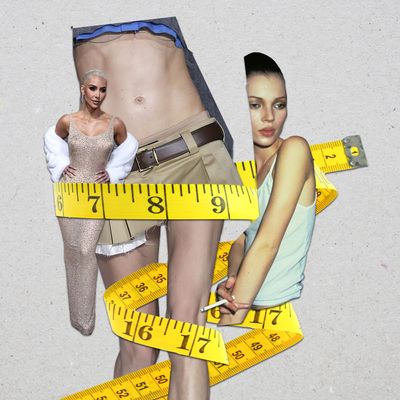
From the ’90s to the aughts and into the 2010s, each decade in recent history has had its own obsession with thinness. Now these past 30 years of youth culture are collapsing in on themselves, leaving nothing but a sliver of space to squeeze through to the other side: Variations of the ’90s “heroin chic body” are now popular search terms on TikTok. The aughts-fashion revival — typified by low-rise “whale tails” and the ubiquitous Miu Miu miniskirt — requires a narrow waist and flat stomach. And the cryptic “pro-ana” language of yesterday’s Tumblr sad girl has made its way onto today’s TikTok.
There’s an argument to be made, depending on how much credit you want to give the Kardashian family, that this particular moment began in late 2018. That was when Kim Kardashian soft-launched her post-BBL era in a KKW Beauty campaign. In images promoting her Classic Blossom makeup collection, she posed on a bed of cherry blossoms, American Beauty style, her neck, torso, thighs, and butt looking unfamiliarly lithe. Despite not following her on social media, I remember seeing this picture everywhere like an omen: Thin is back, baby.
Now, four years and a pandemic later, her transformation has gone beyond Photoshopped ads. She famously bragged about the extreme diet that helped her lose 16 pounds to fit into her archival Marilyn Monroe dress at the Met Gala this year. While her days of endorsing appetite suppressants and laxatives may be behind her, she now promotes “tummy tightening” treatments. And yes, she and her sister Khloé are often subject to increasingly less-speculative speculation that their butts look drastically smaller. But whether Kim reversed her BBL (or even got one in the first place) is besides the point. The job of a cultural icon is to embody the Zeitgeist, and Kim does so literally. A recent viral tweet compares two pictures of her, one from 2017 and another from 2022. The diptych looks like a celebratory before-and-after comparison from a mid-aughts tabloid — plump Kim to the left, gaunt Kim to the right. As Samantha Bush tweeted in response, “Every time i see these pics on the TL I’m stunned because thin is in again and it worries me. My early 2000s PTSD is creeping up.”
It’s obvious the body-positivity movement of the 2010s didn’t have the far-reaching impact one might’ve hoped for — a result of it being coopted by brands eager to capitalize on it but unwilling to meaningfully expand their sizing. The case of Miu Miu’s miniskirt is a perfect example: While Paloma Elsesser wore it on the cover of i-D, the brand does not actually offer the skirt in her size and had to make one custom for the shoot.
“When I say thin is in,” says disability advocate Imani Barbarin, a.k.a. @crutches_and_spice on TikTok, “what I’m talking about is that the inclusion we’ve achieved over the last ten years with the body-positivity and the body-neutrality movements, it’s going to feel like whiplash in terms of going back. It’s going to feel like a resentment of fat bodies.” The short-lived efforts to offer inclusive sizing ranges are already losing steam: Some brands, including Madewell and Reformation, market their larger-than-average size range but don’t actually cater to most fat shoppers in stores. Brands such as Old Navy and Loft ditched their plus-size collections when they didn’t turn out to be instant cash grabs. And whatever aversions to diet culture — or at least to public enthusiasm for diet culture — we might’ve developed over the past ten years are starting to wear off as, once again, diet culture is ubiquitous. At first, we started calling ourselves “skinny legends” as a joke, then it became a socially acceptable compliment, only now we say “snatched.” Even uses of the viral audio “so you think I’m skinny” on TikTok don’t sound like jokes anymore.
One doomscroll down your FYP and it’s hard not to see how every major fashion, lifestyle, and culture trend has connections to the reemerging supremacy of thinness. Ozempic, a diabetes drug already in short supply, is the expensively off-label injectable du jour for rich people looking to slim down fast and document their #myozempicjourney along the way. There is more shameless body checking on main with people posting videos of themselves examining their figures, every protruding bone documented as an accomplishment. Some body checks are hidden in try-on videos and outfit checks just as diet culture is woven into the #thatgirl lifestyle trend of 5 a.m. alarms and green-juice breakfasts.
The truth is our society relied on ableism, fatphobia, and racism to justify the preventable deaths of the pandemic. The Los Angeles Times reported last year that medical fat-shaming increased during the pandemic and got in the way of proper care. It almost makes too much sense that eating disorders got worse during this time. This also happened to be a golden age for fitness: During lockdown, Peloton stocks spiked, and once restrictions let up, people were back in the gym in record numbers. After March 2020, the use of the word fitness was hardly euphemistic: From state abandonment to the anti-vaxxing crusades, enduring the pandemic became a matter of survival of the fittest in the most eugenicist and cruel sense of the word. And who could forget all that talk of the “COVID 15,” as if we were first-year students in a sick undergraduate program? If you are thin in 2022, it means you graduated with honors. If you are thin in 2022, it means your body is productive and valuable and fit, in every sense of the word.
Barbarin theorizes in her viral posts how toxic wellness culture, Y2K fashion trends, the #thatgirl aesthetic, and our growing preoccupation with fitness are examples of how our culture is recoiling against the body-positivity movement, liberal politics, and social progress as a response to the pandemic’s hardships. “The progress we made is going to ricochet backwards,” she says in a TikTok, adding in another, “The pandemic sparked an increase in wellness culture and working towards the ideal body.”
Hailey Tirado, a 24-year-old living and working in Manhattan who shared the before-and-after shot of Kardashian, admits she felt more inclined to pay closer attention to her fitness in the wake of the pandemic. “Personally, in my life and in my friend group, we all kind of got more into fitness lately,” she says. Although their version of fitness is less about daily gym visits and more “just going out and being in the sunshine for a little bit and taking a hot-girl walk,” her conflicting motivations read as familiar. “I want to be the healthiest, best version of myself,” Tirado tells me, “and I do think that, in a way, that means being healthy and losing weight, which it shouldn’t mean that — it shouldn’t mean that your weight determines your worth — but a lot of us feel like it does.”
That’s because being thin in 2022 is about being part of a protected class. It’s about looking fit and healthy and rich and virtuous in a time when we’ve all seen what happens if you don’t have wealth or pretty privilege to protect you. It’s a pursuit of thinness out of the fear of being rejected by everyone from doctors to prospective dates. I think it’s a more desperate pursuit than we’ve seen before.
It doesn’t help that the insidious cult of thinness is not just a mainstream-culture problem: Stormy Wellington, a wealth coach known as Coach Stormy who’s popular among some young Black women and previously unknown to white mainstream audiences, recently became a viral meme for her rant about “low vibrational plates.” (As her “theory” goes, a cookout plate piled high with wings and burgers is a “hood rat” plate compared with her “queen” plate of two wings and half an ear of corn.) It’s no coincidence the most grating bros of the alt-right — Andrew Tate and Joe Rogan, a former kickboxer and a UFC commentator, respectively — are two fitness-obsessed COVID denialists who promote fad diets and insist fatness is a personal choice and a sign of weakness. Even the “radical leftist,” Red Scare–loving, fangirling side of the internet (often called girlbloggers or femcels) seem to think the best way to reject millennial liberalism is to go full-on waif, an aesthetic defined by self-destructive femininity. To look like you’re wasting away is part of the glamour.
If you have heard of the “thin is in” discourse on your FYP or your timeline, you probably saw someone say they survived the thinness craze of the aughts and they’re either prepared or too tired to prepare for its return. In this TikTok, user @katharinadrw jokes about being in recovery just as “‘the heroin chic body’ from the 90s and 2000s is becoming the next body trend.” In another, a registered dietitian asks followers to brace themselves and shares tips on how to “prepare your algorithm” for the impending onslaught of thinness propaganda. For Tirado, her anxiety is shared among the thousands of commenters on the before-and-after Kardashian tweet: a fear that the beauty standard will be lifted too far above our heads for most of us to reach.
As Barbarin says, “thin is in” is reactionary. Anyone who stands to benefit from the current social order will be eager (or feel tempted or pressured) to go all in on fitness and pursue a thin body — to hell with pretending you want to be “healthier.” There is perverse pleasure in controlling our weight. Thinness is seen as a “relatively achievable” ideal in a time when we hunger for ideals. But it’s the fact that it’s seen this way that makes it such a dangerous pursuit. It’s both a pressure and temptation: Because while there are unbridled pleasures to be had in liberating ourselves from the ideal of thinness, the dark impulses that fetishize restrictive diets and spartan gym regiments are often more familiar and easier to satisfy.





